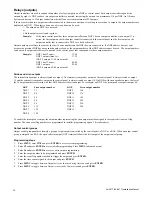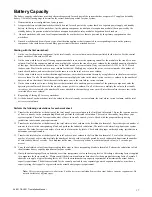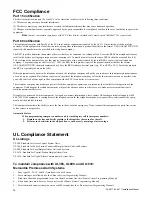
17
AL-2017/AL-3017 Installation Manual
Battery Capacity
The battery capacity calculations must be performed separately for each part of the system that has a separate AC supply and standby
battery. Use the following steps to determine the correct battery capacities for your system:
1.
Determine the exact configuration of your system.
2.
A separate battery calculation worksheet should be used for each part of the system that has a separate power supply and standby
battery. In the top row of the worksheet, list the primary component (control panel or expansion module) that is powered by the
standby battery. Expansion modules include zone expander modules, relay modules, keypads and card readers.
3.
On each worksheet, add rows for all expansion modules or other devices that are powered by the primary component on that
worksheet.
4.
On each worksheet, add rows for any type of notification appliance that is connected to corresponding circuits on the primary
component. Also include rows for auxiliary power circuits that have attached devices.
Starting with the first worksheet:
5.
On the row for the primary component, in the total standby current column, enter the current listed for that device. For the control
panel worksheet, this value is 200mA.
6.
On the same worksheet, in any following expansion module rows, enter the operating current for the module in the standby current
column. On all of the expansion module rows, multiply the value in the standby current column by the attached quantity of modules
of that type. Enter the result in the same row, in the total standby current column. If any row contains AL-1191 or AL-1193 card
readers, enter 80mA in the active current column for that row. Multiply any value in the active current column by the number of
attached card readers, and enter the result in the same row, in the total active current column.
7.
On the same worksheet, in each notification appliance row, enter the alarm current drawn by a single device in the alarm current per
device column. On all of the notification appliance rows multiply the value in the alarm current per device column by the number of
devices used on that circuit. Enter the result in the same row, in the total alarm current column.
8.
On the same worksheet, in rows listing devices that are attached to auxiliary power terminals of the primary component, enter the
operating current for each device in the standby current per device column. On all of these rows, multiply the value in the standby
current per device column by the number of devices attached to that auxiliary power circuit. Enter the result in the same row, in the
total standby current column.
9.
Repeat steps 5 through 8 for every worksheet.
10. At the bottom of each worksheet, total the values in the total standby current column, the total alarm current column, and the total
active current column.
Perform the following calculations for each worksheet:
11. Transfer the totaled value at the bottom of the total standby current column to the first blank in formula 1. Enter the required number
of hours in standby in the corresponding blank, and perform the indicated calculation. The result is the standby Amp-hours your
system requires. The value for required number of hours in standby varies by locale. Check with the proper authority having
jurisdiction to determine your requirements.
12. Transfer the totaled value at the bottom of the total alarm current column to the first blank in formula 2. Enter the required number of
minutes in alarm in the corresponding blank, and perform the indicated calculation. The result is the alarm Amp-hours your system
requires. The value for required number of minutes in alarm varies by locale. Check with the proper authority having jurisdiction to
determine your requirements.
13. Transfer the totaled value at the bottom of the total active current column to the first blank in formula 3. To calculate the required
number of seconds active value, multiply the number of times a card is typically passed by a card reader each hour times the number
of card readers, times 5 seconds. For a medium traffic area, 12 accesses per hour is a commonly used value (i.e. 5 seconds per
access).
14. Carry the calculated values from the preceeding three steps to the corresponding blanks in formula 4. Perform the calculation to find
the minimum battery capacity requirement for your system.
15. Due to the natural aging effects on batteries over time, temperature cycles, and varying levels of discharge, a derating factor is applied
to compensate for these variables. Please consult the battery manufacturer data sheets for the appropriate derating factor. Formula 5
shows how to apply a typical derating factor of 1.15 to the minimum battery capacity requirement to determine the actual battery
capacity requirement. The batteries selected for the control panel and for any separately powered expansion modules, must have a
capacity rating that is equal to or greater than the actual battery capacity requirement.
Note: This system may require two batteries. Each battery must individually meet the actual battery capacity requirement. Do
not mix batteries of different types.







































